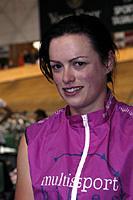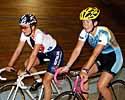
Recently on Cyclingnews.com |
Introduction to Track Racing - What's a Wheelrace? - Introduction to Six Day racing
Tasmanian Christmas Carnivals
Tasmania, December 26, 2004 - January 1, 2005
An interview with Liz Williams, December 29, 2004
The Ulmer influence builds track cycling in NZ
By Gerard Knapp

|
When New Zealand rider Sarah Ulmer smashed the world record for the women's 3km individual pursuit at the Athens 2004 Olympic Games, she secured what was then New Zealand's only gold medal of the Games. Consequently, the country's media focused its attention on the attractive blonde rider, who's remained down-to-earth despite her stratospheric performances, and in turn, track cycling has benefited from the extra attention.
According to Kiwi sprinter Liz Williams, currently in Tasmania racing at the Christmas Carnivals, the positives are already starting flow after Ulmer's efforts in Athens, as well as the two gold medals the country secured at the 2004 track cycling world championships in Melbourne, with Ulmer winning the IP and Greg Henderson the scratch race.
"Sarah has been amazing, she's putting so much in and helping boost the sport's profile," said Williams. "After Sarah won just about every schoolgirl is getting on a bike and Sarah has been really generous in going to schools and encouraging kids to get into it. It's huge."
As for Williams, she is now being coached in Melbourne by John Beasley, who is also credited with converting Australian road cyclist Katie Mactier into the track rider who took silver in the IP behind Ulmer in Athens. Williams said she had already improved under Beasley's instruction and was hoping to continue her development in time for the world championships in Los Angeles in March next year.
"Sarah has been amazing and now, everyone is expecting us to do well," she said of the flow-on effect of Ulmer's gold medal performance in Athens.
The Kiwis are also investing more in cycling and the sport's governing body in New Zealand, Bike NZ, recently hired Australian, Michael Flynn, as the sport's high performance manager. Flynn was a central player in Australia's cycling success in Athens and it's hoped his experience for managing athletes will lead to further success. Already, the team has sent its largest-ever contingent of female riders to the LA round of the track world cup in December and Bike NZ is also sending a 'B team' to the Manchester round of the World Cup, "and we've never had a B team go to any of the rounds", added Williams.
Further, it plans to send an even larger squad to the Sydney round in the hope of qualifying even more spots for the Track Cycling World Championships, to be held in Los Angeles in March next year. Even the facilities for track cycling are looking up. A new covered timber velodrome is due for completion in mid-2005 in the city of Invercargill. Despite its location at the bottom of the South Island, where Williams said "it gets up to about 10 degrees in summer, it's the last town in the country before you hit the Antarctic", she said the new track will be a huge boost to the sport.
Williams paid credit to Tim Shadbolt, the Mayor of Invercargill, who was the driving force behind the new track, which she believes should only lead to even more youngsters taking up the sport.
Remembering Sam Hellyer

|
While competing at the Launceston Carnival on December 28, New Zealand's leading female sprinter saw the Launceston Women's Wheelrace as an opportunity to commemorate her friend, the brilliant Tasmanian teenager Samantha Hellyer, who was tragically killed this year in a road racing accident.
At only 14, Hellyer clearly won the 2003 wheelrace and "when she did it, she caned a field of senior riders, she was brilliant. We all tried to catch her but we just couldn't", said Williams, one of the fastest women at the Carnivals.
To many experienced observers of cycling in Tasmania, Hellyer was a rare talent and her loss is deeply felt, so much so that it's a difficult topic to bring up during competition. Making the tragedy even more poignant is that in contrast to her recent successes on the track, Hellyer had also been a 'ward of the state', spending part of her life in an orphanage after being abandoned as a small child. However, she was taken in by a caring foster family and developed a positive attitude towards her schooling and cycling.
Her memory was at the back of Williams' mind as she lined up for the final of the wheelrace in her distinctive fuschia pink skinsuit (similar to the T-Mobile strip but carrying the logo of one of her sponsors, NZ's Multisport Bikes), an outfit that Hellyer herself used to wear after she was given a set by the Kiwi rider. Williams, 23, admired and liked the talented teenager, as did almost all of Tasmania's close-knit cycling community. Williams had became close to Hellyer's foster parents and is staying with them while competing in the State for the series of Carnivals.
"Sam was just awesome, just awesome. She was riding just over 12 seconds for a flying 200 (a short time trial over 200 metres that defines the sprinting hierarchy at track meets) and I was just at the Los Angeles round of the World Cup and there were senior women there who couldn't get below 13 seconds."
Win wasn't to be
This year's women's wheelrace was taken out by TIS-Cyclingnews rider Louise Yaxley, who rode off a 30-metre advantage, while Williams and the three other ‘scratch' riders, including Rochelle Gilmore and Belinda Goss, failed to make contact with the middle-markers in the handicap event. (To learn more about Wheelraces, please see our background article.)
"I tried to get on (to the middle-markers) but waited and then realized the others weren't going to get across," she said. "I should have just started off with my 500 metre time trial and closed the gap myself They (Yaxley and teammate Natasha Mapley) just went and we couldn't get across. I think everyone is a bit tired, as we had been racing all day." However, it also seems the result may have been another case of the Tasmanians working together - or not working - to ensure another local victory, as the podium was filled by Tasmanian riders.

|
Williams and the A grade women then backed up less than 30 minutes later for the scratch race. Williams positioned herself well in that endurance event, taking the wheel of Australian speedster Rochelle Gilmore on the final lap and coming around the outside as the two fastest women put it on a fine display.
Williams was clearly gaining on the Australian and as they both threw their bikes at the line, many observers believed the New Zealander had won. But the judges ruled the Gilmore was ahead by a tyre's width as they crossed the line.
"I'm staying with her (Sam Hellyer's) foster parents, Jim Smith and Sally Bell, and I really wanted to win something for her, but it wasn't to be. Still, I can't be too disappointed in that (the result of the A grade scratch race), losing to probably the second-best scratch race rider in the world," she said of her extremely close finish with Gilmore.
